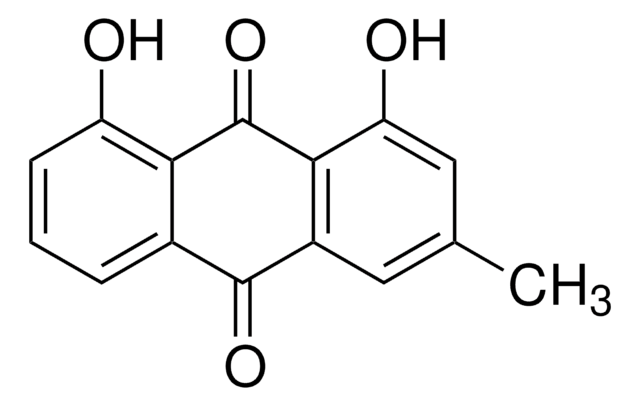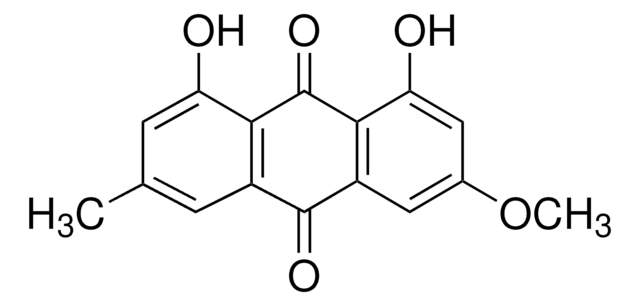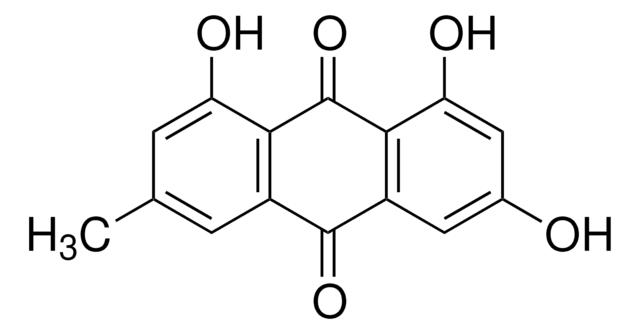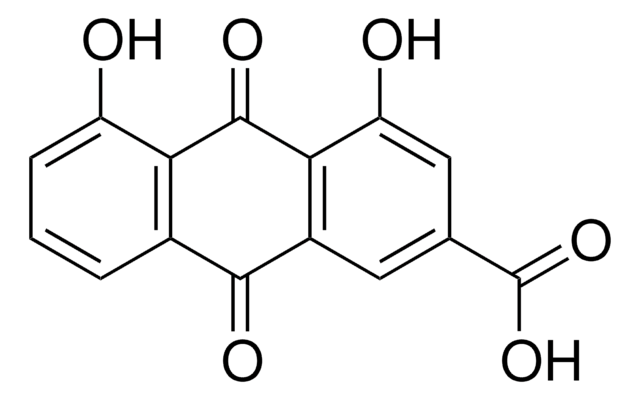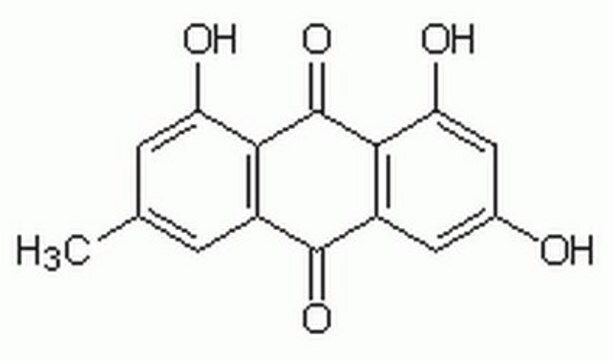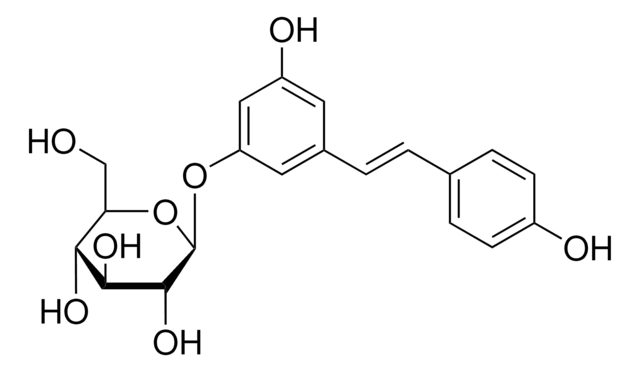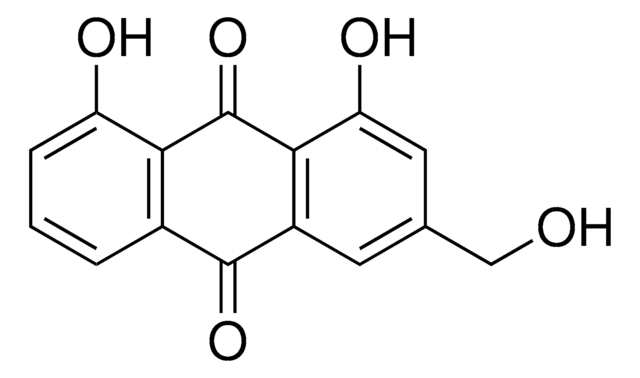93893
Physcion
analytical standard
동의어(들):
1,8-Dihydroxy-3-methoxy-6-methylanthraquinone, 6-O-Methylemodin, 6-Methoxychrysophanic acid, Emodin-3-methyl ether, Parietin, Rheochrysidin
로그인조직 및 계약 가격 보기
모든 사진(2)
About This Item
실험식(Hill 표기법):
C16H12O5
CAS Number:
Molecular Weight:
284.26
Beilstein:
6770499
EC Number:
MDL number:
UNSPSC 코드:
85151701
PubChem Substance ID:
NACRES:
NA.24
추천 제품
Grade
analytical standard
Quality Level
분석
≥98.0% (HPLC)
유통기한
limited shelf life, expiry date on the label
기술
HPLC: suitable
gas chromatography (GC): suitable
응용 분야
food and beverages
형식
neat
저장 온도
2-8°C
SMILES string
COc1cc(O)c2C(=O)c3c(O)cc(C)cc3C(=O)c2c1
InChI
1S/C16H12O5/c1-7-3-9-13(11(17)4-7)16(20)14-10(15(9)19)5-8(21-2)6-12(14)18/h3-6,17-18H,1-2H3
InChI key
FFWOKTFYGVYKIR-UHFFFAOYSA-N
유사한 제품을 찾으십니까? 방문 제품 비교 안내
일반 설명
Physcion is an anthraquinone derivative and is available as the active constituent of Chinese medicinal plants such as Rhubarb, Polygonum cuspidatum and Reynoutria multiflora. It exhibits various biological activities such as antitumor, antimicrobial, antifungal, antioxidant and antihuman cytomegalovirus activity.
애플리케이션
Physcion may be used as an analytical reference standard for the quantification of the analyte in medicinal plants, pharmaceutical preparations, vegetables, herbs and liquors using different chromatography techniques.
Refer to the product′s Certificate of Analysis for more information on a suitable instrument technique. Contact Technical Service for further support.
생화학적/생리학적 작용
Anthraquinone-derivative found in medicinal herbs.
포장
Bottomless glass bottle. Contents are inside inserted fused cone.
추천 제품
Find a digital Reference Material for this product available on our online platform ChemisTwin® for NMR. You can use this digital equivalent on ChemisTwin® for your sample identity confirmation and compound quantification (with digital external standard). An NMR spectrum of this substance can be viewed and an online comparison against your sample can be performed with a few mouseclicks. Learn more here and start your free trial.
신호어
Warning
유해 및 위험 성명서
예방조치 성명서
Hazard Classifications
Acute Tox. 4 Oral
Storage Class Code
11 - Combustible Solids
WGK
WGK 3
Flash Point (°F)
Not applicable
Flash Point (°C)
Not applicable
이미 열람한 고객
Occurrence of emodin, chrysophanol and physcion in vegetables, herbs and liquors. Genotoxicity and anti-genotoxicity of the anthraquinones and of the whole plants
Mueller O.S, et al.
Food And Chemical Toxicology, 37(5), 481-491 (1999)
Henning Hopf et al.
Acta crystallographica. Section C, Crystal structure communications, 68(Pt 8), o317-o319 (2012-08-02)
The structure of the title compound, 7-methoxy-2-methyl-4,5-dihydroxyanthracene-9,10-dione, C(16)H(12)O(5), was originally reported by Ulický et al. [Acta Cryst. (1991). C47, 1879-1881] in the space group P2(1)2(1)2(1) [polymorph (Io)]. The new polymorph, (Im), crystallizes in the space group P2(1)/c. The molecular structures
Gizachew Alemayehu et al.
Natural product communications, 5(5), 747-750 (2010-06-05)
Chrysophanol, physcion, emodin, floribundone-1, 5,7'-physcion-fallacinol, and the novel 5,7'-physcion-physcion-10'-C-alpha-arabinopyranoside were isolated from the stem bark of Senna septemtrionalis. The structures of these secondary metabolites were determined on the basis of spectroscopic analysis, especially from NMR spectra in conjunction with COSY
Y-R Kwon et al.
Oral diseases, 16(2), 204-209 (2010-04-09)
The aim of this study was to separate the anti-acidogenic substances against Streptococcus mutans UA 159 from Polygonum cuspidatum. The anti-acidogenic substances were separated by a series of liquid-liquid fractionations followed by normal-phase silica gel liquid chromatography, based on high-performance
Jie Yu et al.
Journal of ethnopharmacology, 137(3), 1291-1299 (2011-08-16)
Radix Polygoni Multiflori (RPM) and Radix Polygoni Multiflori Praeparata (RPMP) were traditionally widely used as Chinese herbal medicine. However, liver adverse reactions caused by RPM or RPMP were frequently reported all around the world recent years. The aim of this
자사의 과학자팀은 생명 과학, 재료 과학, 화학 합성, 크로마토그래피, 분석 및 기타 많은 영역을 포함한 모든 과학 분야에 경험이 있습니다..
고객지원팀으로 연락바랍니다.